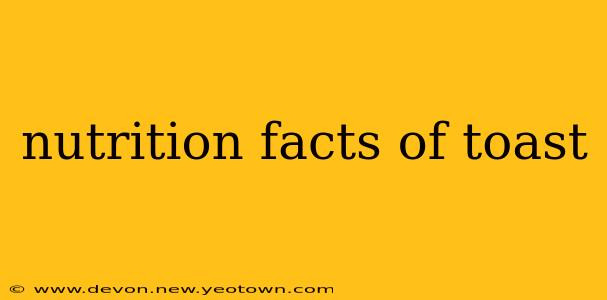Toast. That simple, comforting sound of bread crisping in the toaster. For many, it's the quintessential breakfast, a quick and easy way to start the day. But beyond its satisfying crunch, lies a surprisingly nuanced nutritional profile. Let's delve into the world of toast, uncovering the facts behind this everyday food.
The nutritional content of toast varies dramatically based on the type of bread used. A simple slice of white bread toast offers a different nutritional landscape than a slice of whole-wheat sourdough. We’ll explore these differences, addressing common questions and uncovering some surprising truths.
What are the nutritional benefits of toast?
The nutritional benefits of toast hinge heavily on the type of bread you choose. Whole-wheat toast, for example, packs a punch of fiber, which aids digestion and promotes gut health. It also provides essential vitamins and minerals like iron and B vitamins. However, even white bread toast contributes some nutritional value, offering carbohydrates for energy. The key is understanding the differences and making informed choices based on your dietary needs.
How many calories are in a slice of toast?
The calorie count in a slice of toast is surprisingly variable. A single slice of white bread toast typically contains around 70-80 calories, while whole-wheat toast often falls within a similar range. However, this can fluctuate based on the brand, the size of the slice, and any added ingredients. To get the most accurate calorie count, always refer to the nutritional information panel on the bread packaging.
What are the macros in a slice of toast?
The macronutrient profile of toast is primarily composed of carbohydrates. This is especially true for white bread toast, which is lower in protein and fat compared to whole-wheat options. Whole-wheat toast, on the other hand, boasts a higher fiber content, impacting its carbohydrate profile and increasing its nutritional value. Adding toppings further alters the macronutrient balance; a dollop of peanut butter drastically increases the protein and fat content, for instance.
Is toast healthy for weight loss?
The healthiness of toast for weight loss depends heavily on the type of bread and what you put on it. While whole-wheat toast offers fiber, promoting satiety and aiding digestion, it's crucial to be mindful of portion sizes and toppings. Excessive amounts of butter, jam, or other calorie-dense additions can quickly negate any weight-loss benefits. In moderation, and with the right choices, toast can certainly be a part of a healthy weight-loss diet.
What type of toast is the healthiest?
Hands down, whole-wheat toast emerges as the healthiest option. The higher fiber content contributes to better digestion, sustained energy levels, and a feeling of fullness. This helps regulate blood sugar and can contribute to better overall health. However, variety is key; exploring different types of whole-grain breads – like sourdough or rye – can introduce a diverse range of nutrients and flavors.
Does toast raise blood sugar?
The effect of toast on blood sugar levels depends directly on the type of bread. White bread, being largely refined carbohydrates, tends to cause a sharper spike in blood sugar. Whole-wheat toast, with its higher fiber content, causes a slower, more gradual rise, making it a better option for those managing blood sugar levels. Adding toppings can also influence the impact on blood sugar; opting for low-glycemic options like avocado or berries is a healthier choice.
Is toasted bread better than untoasted bread?
Toasting bread does alter its texture and flavor, but it doesn't necessarily make it "better" or "worse" nutritionally. The nutritional content remains largely the same. However, toasting can help to improve the digestibility of some breads and can enhance the flavor profile, making it more palatable for some.
Ultimately, the nutritional value of toast isn't a one-size-fits-all answer. Understanding the differences between bread types, paying attention to portion sizes, and choosing healthy toppings are key to maximizing the benefits of this simple yet versatile food. So, next time you reach for that slice of toast, remember the nutritional secrets hidden within – and enjoy!

